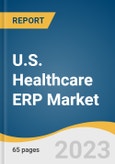Cloud computing technology has triggered a paradigm shift from an on-premise deployment to a cloud-based deployment of ERP solutions in the U. S. Moreover, a hybrid deployment can support the features of both on-premise deployment and cloud-based deployment of these solutions, thereby ensuring cost-effectiveness, data security, and agility in administrative processes. A hybrid deployment also helps in overcoming the cost concerns associated with on-premise deployment and the security concerns associated with cloud-based deployment. Cloud-based deployment of ERP solutions in the U. S. is expected to grow at a rapid pace over the forecast period owing to the benefits associated with the hybrid deployment.
Vendors in the market for healthcare ERP in the U. S. are trying aggressively to increase their customer base and gain a competitive edge over their rivals. They are focusing on licensing and strategic partnerships as part of the efforts toward this end. Companies, such as SAP SE, Microsoft Corporation, and Nuvolo, among others, are also focusing on strategic technology collaborations either to develop new healthcare ERP applications for the U. S. market or to add new capabilities to their existing applications. On the other hand, healthcare providers are also focusing on replacing obsolete technologies with the latest technologies to adapt to the changing requirements.
U. S. Healthcare ERP Market Report Highlights
- The patient relationship management segment is expected to emerge as the fastest-growing segment over the forecast period as medical care providers are finding it challenging to strengthen their relationships with patients owing to the continued enrolment of new patients
- The integration of artificial intelligence (AI) in healthcare ERP solutions is allowing to provide personalized patient care by determining the condition of patients and providing them with the necessary care
- The initiatives undertaken by the government to improve healthcare facilities are expected to open opportunities for the growth of the market
- Medical care administrators in the U. S. are focusing on integrating natural language processing (NLP) programs and machine learning (ML) in their ERP systems to employ predictive analytics in proactively identifying patients
- Some of the key players in the U. S. healthcare ERP market include Epicore Softcare Corporation; Infor; Oracle Corporation; Microsoft Corporation; Sage Software Solution Pvt. Ltd.; and QAD Inc.; among others.
Table of Contents
Companies Mentioned
- Epic Systems Corporation.
- Cerner Corporation
- McKesson Corporation
- Oracle Corporation
- Microsoft Corporation
- Sage Software Solution Pvt. Ltd.
- QAD Inc.
- Media Information Technology, Inc.
- SAP SE
Methodology

LOADING...
Table Information
| Report Attribute | Details |
|---|---|
| No. of Pages | 65 |
| Published | August 2023 |
| Forecast Period | 2022 - 2030 |
| Estimated Market Value ( USD | $ 1.89 Billion |
| Forecasted Market Value ( USD | $ 3.03 Billion |
| Compound Annual Growth Rate | 6.2% |
| Regions Covered | United States |
| No. of Companies Mentioned | 9 |









